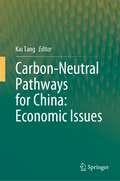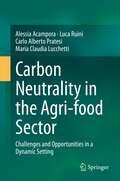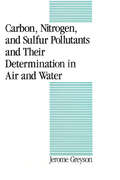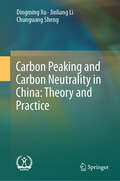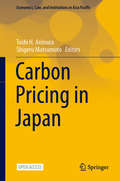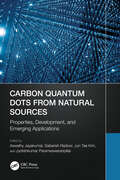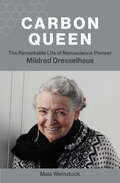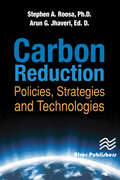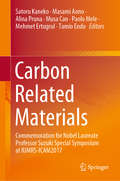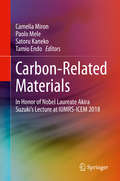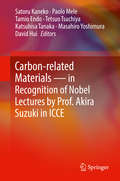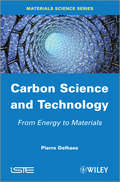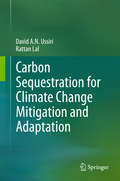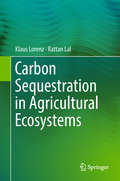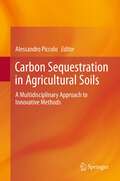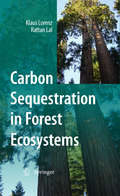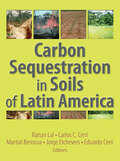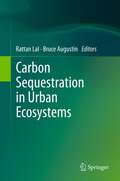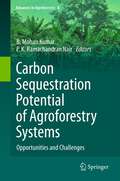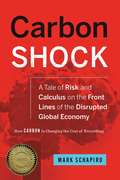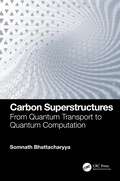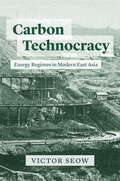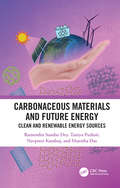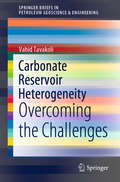- Table View
- List View
Carbon-Neutral Pathways for China: Economic Issues
by Kai TangThis book provides comprehensive economic analyses on the paths to net-zero for China. It gives a detailed overview of issues and challenges related to carbon neutrality of the global largest emitter which have not been adequately addressed e.g., reduction costs and efficiency of existing actions, the multiple impacts of the newly established carbon market, and the potentials and costs of nature-based solutions such as biophysical sequestration, etc. Studies on China’s carbon reduction have attracted scientists and policymakers from diverse backgrounds. Pursuing a holistic and systematic approach, the book establishes a fundamental framework for this topic, emphasizing the importance of integrated technical-economic-policy analysis. This book will not only be an essential reference to the carbon-neutral progress in China but also will be an outstanding text book on carbon-neutral management. Similarly, this book is expected to attract a great range of readership including undergraduate and postgraduate students, economic and climate specialists, researchers and policymakers in China as well as in overseas.
Carbon Neutrality in the Agri-food Sector: Challenges and Opportunities in a Dynamic Setting
by Alessia Acampora Luca Ruini Carlo Alberto Pratesi Maria Claudia LucchettiThis book deals with the in-depth study of sustainability issues in the agri-food sector. In particular, a critical analysis of the current situation was developed and the future prospects of the sector on the issue of managing the environmental variable and the impacts relating to food production and consumption have been analyzed. Furthermore, the state of implementation and best practices relating to the carbon neutrality model in the agri-food sector were analyzed and models for the development of a new food production system were proposed with particular reference to the reduction of emissions, regeneration of natural resources, the elimination of waste and the reuse of production by-products. The main objectives of the book are to analyze the current situation and trends regarding carbon neutrality schemes and the connection with other greening programs, to identify and analyze the carbon-related labels, their methodology and their conformity assessment mechanisms and to understand possible key drivers for carbon neutrality or low carbon achievements in the agri-food sector.Today companies are acting on climate change pressures implementing carbon-neutral strategies for their brands and products. These frontrunner companies have identified a specific competitive advantage and are exploiting it to become the pioneers and the reference model for the carbon neutral implementation. This book will provide detailed and practical insights on how your organization can take positive action and be part of the global response developing a carbon neutral business.
Carbon, Nitrogen, and Sulfur Pollutants and Their Determination in Air and Water
by Jerome C. GreysonFor chemists and engineers in ecology, food science, pollution control, and related fields. Details the procedures available for monitoring and controlling carbon, sulfur, and nitrogen pollutants in such industries as waste water treatment, energy, transportation, pharmaceuticals, and mining. Outlin
Carbon Peaking and Carbon Neutrality in China: Theory and Practice
by Dingming Xu Jinliang Li Chunguang ShengChina has made a major strategic decision to achieve carbon peak before 2030 and carbon neutrality by 2060. The country has formulated a clear timetable, roadmap, and construction plan and introduced the “1+N” policy system from the top. This book provides a theoretical study and practical exploration of nine key aspects related to China's carbon peaking and carbon-neutral strategy: the background of Carbon Peaking and carbon neutrality, scientific and legal basis, strategic planning and path framework, energy-saving and carbon reduction measures, renewable energy, carbon sinks, carbon pricing mechanisms, the green financial system, and practical case studies.The translation was done with the help of artificial intelligence. The present version has been revised technically and linguistically by the authors in collaboration with a professional translator.
Carbon Pricing in Japan (Economics, Law, and Institutions in Asia Pacific)
by Toshi H. Arimura Shigeru MatsumotoThis open access book evaluates, from an economic perspective, various measures introduced in Japan to prevent climate change. Although various countries have implemented such policies in response to the pressing issue of climate change, the effectiveness of those programs has not been sufficiently compared. In particular, policy evaluations in the Asian region are far behind those in North America and Europe due to data limitations and political reasons.The first part of the book summarizes measures in different sectors in Japan to prevent climate change, such as emissions trading and carbon tax, and assesses their impact. The second part shows how those policies have changed the behavior of firms and households. In addition, it presents macro-economic simulations that consider the potential of renewable energy. Lastly, based on these comprehensive assessments, it compares the effectiveness of measures to prevent climate change in Japan and Western countries.Providing valuable insights, this book will appeal to both academic researchers and policymakers seeking cost-effective measures against climate change.
Carbon Quantum Dots from Natural Sources: Properties, Development, and Emerging Applications
by Aswathy Jayakumar Sabarish Radoor Jun Tae Kim Jyotishkumar ParameswaranpillaiCarbon quantum dots (CQDs) are a novel class of zero-dimensional carbon nanomaterials that are relatively nontoxic and cost-effective and offer desirable properties that make them excellent candidates for various applications. This book introduces the fundamentals of CQDs, natural sources and methods used for their synthesis, and characterization techniques. It addresses applications in biomedical, environmental, electrical, and other areas.• Covers current research and future possibilities• Details modern fabrication methods and drawbacks• Discusses applications in biomedical use, wastewater treatment, electrical and electronics, dye removal, 3D printing, and metal detection• Provides insight into cytotoxicity and biocompatibility studies on these materialsThe detailed insight into these nanomaterials in this reference will benefit researchers, scientists, engineers, and advanced students in developing new methods and strategies in this advanced field of materials engineering.
Carbon Queen: The Remarkable Life of Nanoscience Pioneer Mildred Dresselhaus
by Maia WeinstockThe life of trailblazing physicist Mildred Dresselhaus, who expanded our understanding of the physical world.As a girl in New York City in the 1940s, Mildred &“Millie&” Dresselhaus was taught that there were only three career options open to women: secretary, nurse, or teacher. But sneaking into museums, purchasing three-cent copies of National Geographic, and devouring books on the history of science ignited in Dresselhaus (1930–2017) a passion for inquiry. In Carbon Queen, science writer Maia Weinstock describes how, with curiosity and drive, Dresselhaus defied expectations and forged a career as a pioneering scientist and engineer. Dresselhaus made highly influential discoveries about the properties of carbon and other materials and helped reshape our world in countless ways—from electronics to aviation to medicine to energy. She was also a trailblazer for women in STEM and a beloved educator, mentor, and colleague. Her path wasn&’t easy. Dresselhaus&’s Bronx childhood was impoverished. Her graduate adviser felt educating women was a waste of time. But Dresselhaus persisted, finding mentors in Nobel Prize–winning physicists Rosalyn Yalow and Enrico Fermi. Eventually, Dresselhaus became one of the first female professors at MIT, where she would spend nearly six decades. Weinstock explores the basics of Dresselhaus&’s work in carbon nanoscience accessibly and engagingly, describing how she identified key properties of carbon forms, including graphite, buckyballs, nanotubes, and graphene, leading to applications that range from lighter, stronger aircraft to more energy-efficient and flexible electronics.
Carbon Reduction: Policies, Strategies and Technologies
by Stephen A. Roosa Arun G. JhaveriSignificant reduction of local, regional, national and international greenhouse gas emissions in homes, businesses, industries and communities has become an international priority. This book describes in clear, concise, and understandable terms the nature and scope of the climate change problem. The authors combine their considerable expertise to offer guidelines for defining and applying effective carbon reduction policies, strategies, and technologies. They propose a well-defined road map which can be implemented to help control and abate the alarming increases in carbon dioxide and other greenhouse gas emissions.
Carbon Related Materials: Commemoration for Nobel Laureate Professor Suzuki Special Symposium at IUMRS-ICAM2017
by Satoru Kaneko Masami Aono Alina Pruna Musa Can Paolo Mele Mehmet Ertugrul Tamio EndoThis book commemorates the “Nobel Laureate Professor Suzuki Special Symposium” at the International Union of Material Research Society–International Conference on Advanced Materials (IUMRS-ICAM2017), which was held at Kyoto University, Japan, in 2017. The book begins with a foreword by Professor Akira Suzuki. Subsequently, many authors who attended the special symposium describe the latest scientific advances in the field of carbon materials and carbon nanomaterials including polymers, carbon nanocomposites, and graphene. Carbon-based materials have recently been the focus of considerable attention, given their wide range of potential applications. Fittingly, the chapters in this book cover both experimental and theoretical approaches in several categories of carbon-related materials.
Carbon-Related Materials: In Honor of Nobel Laureate Akira Suzuki’s Lecture at IUMRS-ICEM 2018
by Camelia Miron Paolo Mele Satoru Kaneko Tamio EndoThis book will give a detailed description of different carbon based materials synthesis methods, characterization, and applications. It serves as a fundamental information source on the actual techniques and methodologies involved in carbon materials synthesis, such as CVD, plasma in liquids, fusion reactors, or frequency-doubled yttrium–aluminum– garnet (YAG) lasers. This book includes coverage of several categories of carbon materials, such as graphene, carbon fiber composites, functionalized carbons, and polyimides used for various applications, from microelectronic industry to slotted waveguide antennas.
Carbon-related Materials in Recognition of Nobel Lectures by Prof. Akira Suzuki in ICCE
by David Hui Paolo Mele Tamio Endo Tetsuo Tsuchiya Satoru Kaneko Katsuhisa Tanaka Masahiro YoshimuraThis book summarizes the recent advances in carbon related materials. It covers both experimental and theoretical approaches in several categories, including such carbon nanomaterial as polymers, carbon nanocomposites, and graphene. It also discusses device applications, as carbon-based materials that have recently received much attention due to their various potential applications. The editors dedicate this book to Nobel Laureate Akira Suzuki for his 85th birthday.
Carbon Science and Technology: From Energy to Materials
by Pierre DelhaesCarbon solids have been utilized by man since prehistoric times, first as a source of heat and then for other purposes; these are used as key markers for different civilizations. The essential role played by the use of coal mines during the industrial revolution as a main source of energy is a crucial point, which was then expanded through the development of carbochemistry. This book begins by describing the use of solid carbons as traditional materials, for example in the steel industry and for ceramics, then moving on to their technological uses such as active carbons and carbon fibers, etc., before discussing nanocarbons, the jewel in the crown of contemporary technological science. The final chapter analyzes the current economic and social impact of carbon solids.
Carbon Sequestration for Climate Change Mitigation and Adaptation
by Rattan Lal David A. UssiriThis book provides an understanding of the role of human activities in accelerating change in global carbon cycling summarizes current knowledge of the contemporary carbon budget. Starting from the geological history, this volume follows a multidisciplinary approach to analyze the role of human activities in perturbing carbon cycling by quantifying changes in different reservoirs and fluxes of carbon with emphasis on the anthropogenic activities, especially after the industrial revolution. It covers the role of different mitigation options – natural ecological, engineered, and geoengineered processes as well as the emerging field of climate engineering in avoiding dangerous abrupt climate change. Although the targeted audience is the educators, students, researchers and scientific community, the simplified analysis and synthesis of current and up to date scientific literature makes the volume easier to understand and a tool policy makers can use to make an informed policy decisions.
Carbon Sequestration in Agricultural Ecosystems
by Klaus Lorenz Rattan LalA comprehensive book on basic processes of soil C dynamics and the underlying factors and causes which determine the technical and economic potential of soil C sequestration. The book provides information on the dynamics of both inorganic (lithogenic and pedogenic carbonates) and organic C (labile, intermediate and passive). It describes different types of agroecosystems, and lists questions at the end of each chapter to stimulate thinking and promote academic dialogue. Each chapter has a bibliography containing up-to-date references on the current research, and provides the state-of-the-knowledge while also identifying the knowledge gaps for future research. The critical need for restoring C stocks in world soils is discussed in terms of provisioning of essential ecosystem services (food security, carbon sequestration, water quality and renewability, and biodiversity). It is of interest to students, scientists, and policy makers.
Carbon Sequestration in Agricultural Soils: A Multidisciplinary Approach to Innovative Methods
by Alessandro PiccoloThis compilation of techniques, methodologies and scientific data arises from a four-year Italian research project, which took place at university research stations in Turin, Piacenza, Naples and Potenza. Soil Organic Matter (SOM) represents an active and essential pool of the total organic carbon on the planet. Consequently, even small changes in this SOM carbon pool may have a significant impact on the concentration of atmospheric CO2. Recent new understanding of the chemical nature of SOM indicates that innovative and sustainable technologies may be applied to sequester carbon in agricultural soils. Overall results of the project have been applied to develop an innovative model for the prediction and description, both quantitatively and qualitatively, of carbon sequestration in agricultural soils. This book provides experts in different areas of soil science with a complete picture of the effects of new soil management methods and their potentials for practical application in farm management.
Carbon Sequestration in Forest Ecosystems
by Klaus Lorenz Rattan LalCarbon Sequestration in Forest Ecosystems is a comprehensive book describing the basic processes of carbon dynamics in forest ecosystems, their contribution to carbon sequestration and implications for mitigating abrupt climate change. This book provides the information on processes, factors and causes influencing carbon sequestration in forest ecosystems. Drawing upon most up-to-date references, this book summarizes the current understanding of carbon sequestration processes in forest ecosystems while identifying knowledge gaps for future research, Thus, this book is a valuable knowledge source for students, scientists, forest managers and policy makers.
Carbon Sequestration in Soils of Latin America
by Rattan Lal Carlos C. Cerri Martial Bernoux Jorge Etchevers Eduardo CerriDiscover the latest available knowledge on ways to reduce CO2 in the atmosphere!The problem of quickly mounting CO2 emissions in the fast-developing Latin American region was addressed in a symposium held in Piracicaba, Brazil, in June 2004. Carbon Sequestration in Soils of Latin America presents the latest available knowledge in soil C
Carbon Sequestration in Urban Ecosystems
by Rattan Lal Bruce AugustinUrbanization drastically alters the ecosystems structure and functions, disrupts cycling of C and other elements along with water. It alters the energy balance and influences climate at local, regional and global scales. In 2008, urban population exceeded the rural population. In 2050, 70% of the world population will live in urban centers. The number of megacities (10 million inhabitants) increased from three in 1975 to 19 in 2007, and is projected to be 27 in 2025. Rapid urbanization is altering the ecosystem C budget. Yet, urban ecosystems have a large C sink capacity in soils and biota. Judicious planning and effective management can enhance C pool in urban ecosystems, and off-set some of the anthropogenic emissions. Principal components with regards to C sequestration include home lawns and turfs, urban forests, green roofs, park and recreational/sports facilities and urban agriculture.
Carbon Sequestration Potential of Agroforestry Systems: Opportunities and Challenges (Advances in Agroforestry #8)
by P. K. Nair B. Mohan KumarTree based production systems abound especially in the tropics. Despite the pervasiveness of such multipurpose "trees-outside-forest" resources, they have not attracted adequate attention in the development paradigms of many nation states. These multispecies production systems impact the ecosystem processes favourably. Yet, our understanding of the diversity attributes and carbon dynamics under agroforestry is not adequate. This book focuses on the role of multispecies production systems involving tree and crop species as a means for carbon sequestration and thereby reduce atmospheric carbon dioxide levels. Sixteen chapters organized into three broad sections titled: Measurement and Estimation, Agrobiodiversity and Tree Management, and Policy and Socioeconomic Aspects represent a cross section of the opportunities and challenges in current research and emerging issues in harnessing carbon sequestration potential of agroforestry systems.
Carbon Shock
by Mark SchapiroAs the world moves toward making more and more polluters pay to emit carbon, a financial mystery unfolds: What are the costs? Who has the responsibility to pay for them? Who do you pay? How do you pay? And what are the potential impacts? These are the questions veteran journalist Mark Schapiro attempts to answer as he illuminates the struggle to pinpoint carbon’s true costs and allocate them fairly—all while bumping up against the vagaries of the free market, the lobbying power of corporations, the political maneuverings of countries, and the tolerance of everyday consumers buying a cup of coffee, a tank of gas, or an airplane ticket. Along the way, Schapiro tracks the cost of carbon through the drought-ridden farmland of California, where higher temperatures are driving up the price of the food we eat, the prices farmers pay for crop insurance, and the impact on taxpayers. Through the jungles of Brazil, where foreign polluters pay to keep trees standing—as offsets to absorb CO2—at a fraction of the cost they are worth to the struggling communities around them, who engage in logging or other uses. Through the world's greatest manufacturing center, asking who should pay for the pollution generated there—the Chinese who operate the factories or the Westerners who consume the goods they produce? Through the skies, where recent efforts to put a price tag on the carbon left by airplanes in the no-man's land of the atmosphere created what amounted to a quiet but powerful global trade war. Through the carbon-trading capital of Europe, where economists try to establish a price for a bizarre new commodity—a ton of carbon that will not be emitted—literally selling the air in an effort to curtail emissions. And, finally, through the high-tech crime world the new carbon markets have inspired, and the emerging nations that—as they amp up manufacturing, put more cars on their streets, and up their consumption—teeter on the brink of this wild, new carbon economy. For almost two decades, the primary topic of global climate negotiations has been to find a way to pay for the costs of carbon, slow greenhouse gas emissions, and stimulate a shift away from fossil fuels in order to shrink the earth’s carbon footprint. The key tool to date—the international carbon trade—has foundered in a sea of questions deftly explored by Schapiro, and in the turmoil of a global recession. As we approach the next climate negotiations in 2015, will nations stick to business as usual? Or will the world come to terms with the real price for carbon, and figure out a sensible way to pay for it?
Carbon Superstructures: From Quantum Transport to Quantum Computation
by Somnath BhattacharyyaThis book covers how the understanding, as well as controllability, of the quantum electronic properties of carbon structures can be improved through a combined study of structural geometry, electronic properties, and dynamics of resonating valence bonds. It elaborates varied properties such as growth mechanism, exotic transport properties, namely unusual geometry of microstructures mixed with electron distribution and spin properties in carbon. Transport mechanisms and new applications including hybrid quantum technology based on the superconducting diamond and diamond nitrogen-vacancy (NV) centers are discussed.Features:• Includes the theoretical and experimental aspects of carbon physics, various carbon nanostructures, and simulations.• Covers growth of carbon superstructures and various applications of their tunable electronic properties.• Discusses how nanocarbon systems can be used in emerging technologies, including spintronic and quantum computing.• Focuses on spin-related features and spin transport including the Kondo effect, spin-charge separation, spin-phonon coupling, anomalous Hall effect, and Luttinger liquid features.• Explores carbon superstructure growth and their tunable electronic properties.This book is aimed at students, researchers in physics, chemistry, engineering, materials science, electronics, and quantum technology.
Carbon Technocracy: Energy Regimes in Modern East Asia (Studies of the Weatherhead East Asian Institute)
by Victor SeowA forceful reckoning with the relationship between energy and power through the history of what was once East Asia’s largest coal mine. The coal-mining town of Fushun in China’s Northeast is home to a monstrous open pit. First excavated in the early twentieth century, this pit grew like a widening maw over the ensuing decades, as various Chinese and Japanese states endeavored to unearth Fushun’s purportedly “inexhaustible” carbon resources. Today, the depleted mine that remains is a wondrous and terrifying monument to fantasies of a fossil-fueled future and the technologies mobilized in attempts to turn those developmentalist dreams into reality. In Carbon Technocracy, Victor Seow uses the remarkable story of the Fushun colliery to chart how the fossil fuel economy emerged in tandem with the rise of the modern technocratic state. Taking coal as an essential feedstock of national wealth and power, Chinese and Japanese bureaucrats, engineers, and industrialists deployed new technologies like open-pit mining and hydraulic stowage in pursuit of intensive energy extraction. But as much as these mine operators idealized the might of fossil fuel–driven machines, their extractive efforts nevertheless relied heavily on the human labor that those devices were expected to displace. Under the carbon energy regime, countless workers here and elsewhere would be subjected to invasive techniques of labor control, ever-escalating output targets, and the dangers of an increasingly exploited earth. Although Fushun is no longer the coal capital it once was, the pattern of aggressive fossil-fueled development that led to its ascent endures. As we confront a planetary crisis precipitated by our extravagant consumption of carbon, it holds urgent lessons. This is a groundbreaking exploration of how the mutual production of energy and power came to define industrial modernity and the wider world that carbon made.
Carbon Technocracy: Energy Regimes in Modern East Asia (Studies of the Weatherhead East Asian Institute)
by Victor SeowA forceful reckoning with the relationship between energy and power through the history of what was once East Asia’s largest coal mine. The coal-mining town of Fushun in China’s Northeast is home to a monstrous open pit. First excavated in the early twentieth century, this pit grew like a widening maw over the ensuing decades, as various Chinese and Japanese states endeavored to unearth Fushun’s purportedly “inexhaustible” carbon resources. Today, the depleted mine that remains is a wondrous and terrifying monument to fantasies of a fossil-fueled future and the technologies mobilized in attempts to turn those developmentalist dreams into reality. In Carbon Technocracy, Victor Seow uses the remarkable story of the Fushun colliery to chart how the fossil fuel economy emerged in tandem with the rise of the modern technocratic state. Taking coal as an essential feedstock of national wealth and power, Chinese and Japanese bureaucrats, engineers, and industrialists deployed new technologies like open-pit mining and hydraulic stowage in pursuit of intensive energy extraction. But as much as these mine operators idealized the might of fossil fuel–driven machines, their extractive efforts nevertheless relied heavily on the human labor that those devices were expected to displace. Under the carbon energy regime, countless workers here and elsewhere would be subjected to invasive techniques of labor control, ever-escalating output targets, and the dangers of an increasingly exploited earth. Although Fushun is no longer the coal capital it once was, the pattern of aggressive fossil-fueled development that led to its ascent endures. As we confront a planetary crisis precipitated by our extravagant consumption of carbon, it holds urgent lessons. This is a groundbreaking exploration of how the mutual production of energy and power came to define industrial modernity and the wider world that carbon made.
Carbonaceous Materials and Future Energy: Clean and Renewable Energy Sources
by Ramendra Sundar Dey Taniya Purkait Navpreet Kamboj Manisha DasModern lifestyle demands consistent supply of energy for our daily need and comfort. To encounter global demands for energy and to permit for diminution of fossil fuels, there is an urgent need for efficient, sustainable and clean energy sources. Carbonaceous material such as graphene, carbon nanotubes, fullerenes, mesoporous carbon, carbon nanofibres and their composites are extensively studied material. They are playing important role to alternative clean energy sources. This book reviews the roadmap of various form of carbonaceous materials used in several energy devices and provides guideline of future perspective.
Carbonate Reservoir Heterogeneity: Overcoming the Challenges (SpringerBriefs in Petroleum Geoscience & Engineering)
by Vahid TavakoliThis book provides a comprehensive overview of the parameters and factors that cause heterogeneity in carbonate reservoirs, and examines how they interact with one another. It explores the various scales of heterogeneity, how they are caused, and how they can be minimized, as well as how the scales affect each other, providing practical examples in each chapter. The book concludes by discussing the effect of heterogeneity on petrophysical evaluations. As reducing heterogeneity is the only way to obtain accurate carbonate reservoir characteristics at the regional scale, the book offers an important reference guide for all geologists, engineers, and modelers working with subsurface data.
